Picture this: The conference room buzzes with anticipation.
An ESG officer steps forward to present a sustainability initiative to the finance committee—projected investment: $150,000. Projected return: “brand reputation improvement” and “alignment with corporate values.”
The CFO’s expression shifts.
Organizations face mounting pressure to achieve ESG goals, yet the persistent myth of the “green premium”—that sustainability necessarily costs more—creates unnecessary friction.
Another passionate proposal meets the wall of fiscal reality, another chance to demonstrate genuine environmental leadership slips away because we’ve been conditioned to believe that green initiatives drain budgets rather than fuel them.
This scene unfolds in boardrooms nationwide with frustrating regularity. Organizations face mounting pressure to achieve ESG goals from investors, regulators, employees, and customers. Yet the persistent myth of the “green premium”—that sustainability necessarily costs more—creates unnecessary friction between environmental objectives and smart financial strategy. Broadcast studios, with their incredible appetite for electricity, represent some of the most energy-intensive environments in the corporate ecosystem, and lighting typically devours the largest share of that power.
What transforms this narrative? Hard numbers that tell a compelling story.
Verified performance data that speaks the language of ROI. A documented case where environmental responsibility delivers measurable financial returns within standard capital equipment cycles. The Home Depot broadcast studio transformation provides exactly that proof: an impressive 95% energy reduction achieved through smart LED lighting implementation, delivering complete cost recovery in just 18 months while simultaneously crushing corporate sustainability goals.
From 45 Kilowatts to 2.2 Kilowatts: Documenting the Transformation
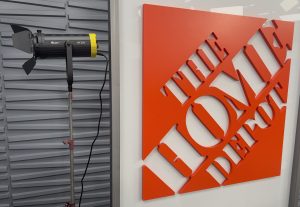 Home Depot‘s broadcast studio faced the same challenges that plague most corporate video facilities. Traditional tungsten and early-generation LED lighting arrays consumed a hefty 45 kilowatts during peak production sessions. At commercial electricity rates averaging $0.12 per kWh, the annual energy cost for lighting alone—running 250 production days with four-hour average sessions—exceeded $54,000. Beyond the direct utility expense, the thermal output from 45kW of lighting demanded aggressive HVAC compensation, adding thousands more to operational costs. The inflexibility of the legacy system required extensive manual pre-tuning for talent with diverse skin tones, consuming valuable production time. Complex electrical infrastructure meant every modification or expansion triggered time-consuming permitting processes, inspection delays, and costly electrician callouts.
Home Depot‘s broadcast studio faced the same challenges that plague most corporate video facilities. Traditional tungsten and early-generation LED lighting arrays consumed a hefty 45 kilowatts during peak production sessions. At commercial electricity rates averaging $0.12 per kWh, the annual energy cost for lighting alone—running 250 production days with four-hour average sessions—exceeded $54,000. Beyond the direct utility expense, the thermal output from 45kW of lighting demanded aggressive HVAC compensation, adding thousands more to operational costs. The inflexibility of the legacy system required extensive manual pre-tuning for talent with diverse skin tones, consuming valuable production time. Complex electrical infrastructure meant every modification or expansion triggered time-consuming permitting processes, inspection delays, and costly electrician callouts.
The solution we implemented represented a complete reimagining of studio lighting architecture. 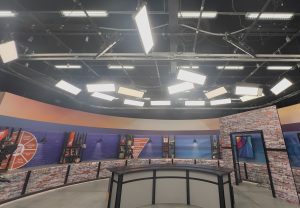
Home Depot embraced large broadcast-grade LED panel lights featuring beautifully soft, forgiving illumination and bicolor capability spanning 3200K to 5600K. The new system integrated seamlessly with existing studio infrastructure while fundamentally transforming power requirements.
Post-implementation measurements verified what many sustainability advocates promise but rarely deliver with such precision: peak power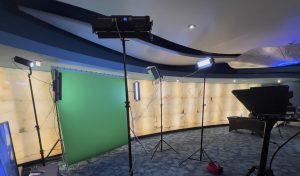 consumption dropped to just 2.2 kilowatts per production session. The reduction of 42.8 kilowatts represents an outstanding 95.1% decrease in lighting energy consumption. Annual energy savings calculated against the same 250-day, four-hour production schedule total 42,800 kWh, translating to $5,136 in direct electricity cost avoidance. Over a five-year equipment lifespan, that single line item delivers $25,680 in cumulative savings.
consumption dropped to just 2.2 kilowatts per production session. The reduction of 42.8 kilowatts represents an outstanding 95.1% decrease in lighting energy consumption. Annual energy savings calculated against the same 250-day, four-hour production schedule total 42,800 kWh, translating to $5,136 in direct electricity cost avoidance. Over a five-year equipment lifespan, that single line item delivers $25,680 in cumulative savings.
Operational benefits extended far beyond the utility bill. Eliminated electrician callouts for every production saved approximately $500 per month in labor costs. Reduced heat generation decreased HVAC demand by an estimated 20%, adding another $8,400 annually to the savings column. Automated lighting scenes replaced
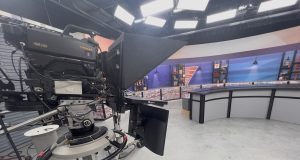 manual tuning procedures, reclaiming 30 minutes of production time per session—time that could be monetized or redirected to creative refinement. The total annual operational savings approached $20,000 when all factors were calculated.
manual tuning procedures, reclaiming 30 minutes of production time per session—time that could be monetized or redirected to creative refinement. The total annual operational savings approached $20,000 when all factors were calculated.
Financial modeling against the total project investment—equipment, installation, and integration costs totaling approximately $36,000—revealed a simple payback period of 18 months. By month 60, cumulative savings exceeded $100,000. The internal rate of return easily cleared the threshold required for capital equipment investments in most corporate finance frameworks.
Power-over-Ethernet Technology: Engineering Efficiency at the Infrastructure Level
Traditional AC-powered studio lighting suffers from inherent inefficiencies embedded in the power delivery architecture. Wall power undergoes multiple conversion stages—AC to DC transformation through drivers, voltage regulation through transformers, and resistive dimming that dissipates unwanted energy as heat. Each conversion stage bleeds efficiency. Conventional systems typically convert only 40-60% of supplied wall power into usable illumination, with the remainder wasted as heat and electromagnetic interference.
Power-over-Ethernet (PoE) technology reconstructs this equation from the ground up.
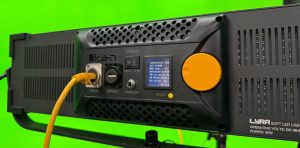
1 cable for power & data
DC power delivery eliminates multiple conversion stages. Lower operating voltages generate significantly less waste heat. LED technology optimized specifically for PoE voltage characteristics operates at peak efficiency. Network switching infrastructure proves inherently more efficient than traditional electrical distribution systems. Well-engineered PoE lighting systems achieve impressive 80-90% efficiency, converting the vast majority of supplied power directly into brilliant light output.
The efficiency gains multiply at the system level. Reduced heat generation decreases HVAC load proportionally—cooling costs decline alongside lighting costs. Centralized PoE power sourcing in network closets enables superior load management compared to distributed electrical circuits. Network control allows intelligent power-down of unused fixtures, eliminating the “phantom load” characteristic of always-on dimmer racks. The result is a virtuous cycle where efficiency improvements in one subsystem drive efficiency improvements across the entire ecosystem.
For organizations ready to embrace the Home Depot model, PoE systems like Ikan’s Lyra series deliver broadcast-quality illumination with elegantly simple single-cable installation. The LBX10-POE and LBX8-POE panels provide stunning bicolor capability, ArtNet and sACN DMX control, and exceptional 97+ CRI performance while drawing power through standard Cat6 Ethernet cabling.
Hidden Value: Cost Avoidance Beyond the Utility Bill
Energy savings anchor the ROI calculation, but a comprehensive financial analysis reveals multiple layers of cost avoidance that accelerate payback timelines and maximize long-term value.
Permitting Complexity Eliminated: Traditional high-wattage studio lighting requires electrical permits in most jurisdictions—a process that introduces permit fees ($500-$2,000), inspection scheduling delays (two to eight weeks), and associated project management overhead. PoE qualifies as low-voltage network equipment in most building codes, exempting it from electrical permitting requirements. Organizations save both direct costs and timeline acceleration, enabling installations during compressed windows like university break periods or corporate calendar year-ends.
Installation Labor Economics:
Licensed electricians command premium hourly rates and carry scheduling constraints that can delay projects. PoE installations require network technicians—specialists with different rate structures and typically greater availability. Standard Cat6 cabling replaces complex conduit runs and junction box installations. The elimination of inspection holds removes a critical path dependency. Aggregate installation time decreases 40-60%, with labor cost reductions of 25-40% depending on regional labor markets.
Infrastructure Adaptability:
Spaces evolve. Productions change. Organizations grow. Repositioning electrical lighting fixtures triggers electrician callouts and potential permitting if circuits require modification. Network cabling offers dramatically greater flexibility for reconfiguration. Fixture repositioning becomes a straightforward facilities management task rather than a licensed trade activity. Scalability responds to available PoE switch port capacity rather than electrical circuit capacity—a constraint that’s simpler and less expensive to address. Future technology upgrades can be delivered via firmware updates rather than costly hardware replacement.
Thermal Load Reduction:
The impressive 42.8 kW difference between Home Depot’s before and after states represents approximately 146,000 BTU/hour of heat reduction. In climate-controlled studio environments, every watt of lighting heat eliminated translates directly to reduced cooling demand. The HVAC savings vary by geographic location and local utility rates, but the principle remains universal: cooler operating environments extend equipment lifespan across all systems while simultaneously reducing cooling costs.
Quantifying Environmental Impact for ESG Reporting
Sustainability officers need more than compelling stories—they need reporting metrics that align with recognized frameworks and satisfy stakeholder scrutiny while telling a powerful environmental story.
The remarkable 42,800 kWh annual savings achieved in Home Depot’s implementation converts to carbon emissions reduction using EPA eGRID regional factors. In most U.S. regions, the grid emissions factor ranges from 0.7 to 1.0 pounds of CO₂ per kWh. Using a conservative 0.85 lb/kWh factor, the Home Depot studio avoids 18.2 metric tons of CO₂ equivalent emissions annually. EPA equivalency calculators translate that figure to meaningful comparisons: 4.5 passenger vehicles removed from roads for one year, or 2,200 tree seedlings grown for 10 years.
Corporate sustainability reporting follows established frameworks that require specific metric disclosure. The Global Reporting Initiative (GRI) Standards call for energy consumption reporting under GRI 302-1 and emissions reporting under GRI 305-2. The Carbon Disclosure Project (CDP) framework addresses Scope 2 emissions—purchased electricity. The Sustainability Accounting Standards Board (SASB) includes energy management metrics across multiple sectors. LEED and BREEAM certification programs award valuable points for demonstrated energy efficiency improvements in facilities.
Organizations can proudly incorporate verified lighting efficiency improvements into formal disclosure language: “Our broadcast facility achieved an outstanding 95% reduction in lighting energy consumption through innovative LED technology implementation, resulting in 42,800 kWh annual savings and 18.2 metric tons CO₂e emissions avoidance. This initiative demonstrates measurable progress toward our enterprise goal of 30% Scope 2 emissions reduction by 2030.”
The impact of broadcast studio efficiency within enterprise-wide sustainability targets depends on organizational scale, but the principle holds regardless: one studio transformed becomes a replicable model. Campus-wide deployment multiplies impact proportionally. Visible sustainability wins engage employees more effectively than abstract commitments. Concrete, verifiable achievements strengthen stakeholder communications compared to aspirational targets lacking supporting evidence.
Implementation Roadmap: Making Results Replicable
Organizations ready to replicate the Home Depot results can follow a proven methodology that reduces perceived barriers and accelerates smart decision-making.
Energy Audit Foundation: Document current energy consumption through direct measurement—kWh meters, utility bill analysis, or building management system data. Identify lighting’s percentage contribution to total studio load. Calculate baseline costs by multiplying usage patterns by local electricity rates. Note infrastructure constraints, including electrical capacity limits and thermal management challenges. A straightforward assessment worksheet captures critical inputs: current lighting wattage, weekly operating hours, local electricity rate per kWh, and calculated annual baseline cost.
Alternative Modeling: Specify PoE fixture equivalents for the current lighting configuration. Estimate projected power consumption, typically expecting 90-95% reduction when replacing tungsten or early LED systems, and 70-85% reduction when replacing newer traditional LED installations. Calculate projected annual savings by applying the same usage patterns to the dramatically lower power consumption. Determine payback period by dividing total project investment by annual savings.
Stakeholder Alignment Strategy: Finance teams respond enthusiastically to 18-month ROI analysis and comparative evaluation against competing capital project proposals. Facilities teams appreciate permitting avoidance and installation simplicity. ESG and sustainability teams value carbon reduction metrics and reporting framework alignment. IT departments need network capacity assessment—typically a minimal incremental load. Operations teams celebrate quality improvements and workflow efficiency gains. Address each constituency’s priorities using their language and metrics while building excitement for the transformation.
Timeline Expectations: Realistic implementation schedules span just eight weeks from design through commissioning: two weeks for design and specification, two weeks for equipment procurement, two weeks for installation of cabling and fixtures, one week for programming and commissioning, and one week for training and go-live. This timeline often proves faster than traditional electrical retrofits due to eliminated permitting delays.
Enterprise Deployment: Scaling Success Across Multiple Facilities
Autodesk‘s decision to replicate initial studio success across 12 global offices demonstrates the compelling scalability of the model. First-location implementation proved the concept, generated internal case study documentation, and identified refinements before enterprise-scale deployment. Subsequent rollouts benefited from volume equipment pricing, repeatable installation processes that reduced labor hours, and shared training resources deployed through train-the-trainer models.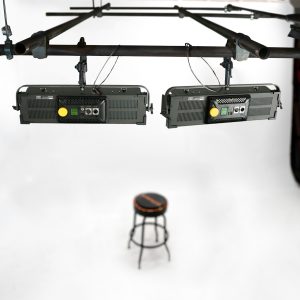
The economics improve dramatically with scale. The first studio delivered an approximate 18-month payback. Studios two through five likely achieved approximate 14-16 month payback through improved pricing and installation learning curve benefits. Studios six and beyond continued the trend and delivered approximate 12-14 month payback as full economies of scale materialized. Centralized PoE infrastructure management enabled IT efficiency improvements across the entire portfolio.
Organizations with multiple facilities should consider phased deployment that builds momentum and expertise. Launch with a single high-visibility studio that proves the concept and generates compelling documentation. Proceed to three to five priority locations with high usage patterns or elevated energy costs, maximizing near-term ROI while building operational expertise. Complete enterprise rollout with standardized specifications, optimized procurement, and full network effects.
Addressing Skepticism: Common Objections Resolved
The impressive 95% reduction applies specifically to transitions from traditional tungsten lighting to advanced LED technology. Actual reduction percentages depend on baseline conditions. Organizations replacing older, less efficient systems see the most dramatic improvements. Even modest starting points typically achieve substantial 70-85% reductions. The percentage matters less than the absolute savings and compelling payback calculation.
Low electricity costs do not eliminate the strong business case. Energy represents one savings category among several valuable benefits. Permitting avoidance delivers $5,000-$15,000 per installation regardless of electricity rates. Installation labor efficiency provides significant 25-40% cost reduction. HVAC savings and operational flexibility add further substantial value. Even in low-cost energy markets, total ROI typically occurs within 24 months.
High-efficiency traditional LED systems remain less efficient than innovative PoE implementations. Modern traditional LED may consume 10-15 kW for equivalent output in a large studio. PoE systems operate efficiently at just 2-3 kW. PoE eliminates multiple power conversion layers that bleed efficiency. Additionally, PoE avoids electrical permitting requirements and associated contractor costs entirely.
Retrofits dominate the successful application profile.
PoE cabling uses existing pathways—conduit, ceiling runs, cable trays. Fixtures mount to standard studio rigging infrastructure. Electrical removal requires circuit decommissioning, not complete tear-out. Typical retrofits prove faster and less invasive than traditional electrical system upgrades.
Upfront costs for quality PoE fixtures align with high-quality traditional LED pricing. Network infrastructure represents the incremental investment, typically adding 15-25% to equipment costs. This is offset by eliminating electrical distribution components—panels, circuits, licensed labor. Total installed cost often proves comparable or better. ROI derives from substantial operational savings rather than reduced capital expenditure.
Many utilities offer attractive commercial energy efficiency rebates. PoE lighting qualifies under lighting and controls programs. Regional rebates vary but can offset 10-30% of project costs. Local utility energy efficiency programs or state-level initiatives provide helpful application support.
Financial Responsibility Meets Environmental Stewardship
The Home Depot broadcast studio transformation validates a proposition that many have articulated but few have proven with such compelling precision: sustainability initiatives can deliver measurable financial returns within timeframes that satisfy rigorous capital budgeting requirements. The outstanding 95% energy reduction, rapid payback, and ongoing operational savings demonstrate that green objectives and financial objectives can align beautifully rather than conflict.
Corporate decision-makers no longer need to choose between fiscal discipline and environmental responsibility. Organizations seeking to satisfy ESG mandates while maintaining budget accountability can point to documented precedent that speaks their language. The technology has matured beautifully. The business case closes under rigorous financial analysis. Implementation has become straightforward and rewarding.
For organizations ready to calculate their specific opportunity, assess current studio energy consumption, model alternative scenarios, and engage the stakeholder conversations that move proposals from consideration to enthusiastic approval. The Home Depot and Autodesk results are absolutely replicable. The ROI is verifiable and compelling. The path forward is clear and exciting.
Calculate your sustainability ROI today. Contact Ikan for a customized energy savings and payback analysis for your studio, or explore Ikan’s PoE lighting solutions designed specifically for broadcast studio applications.
